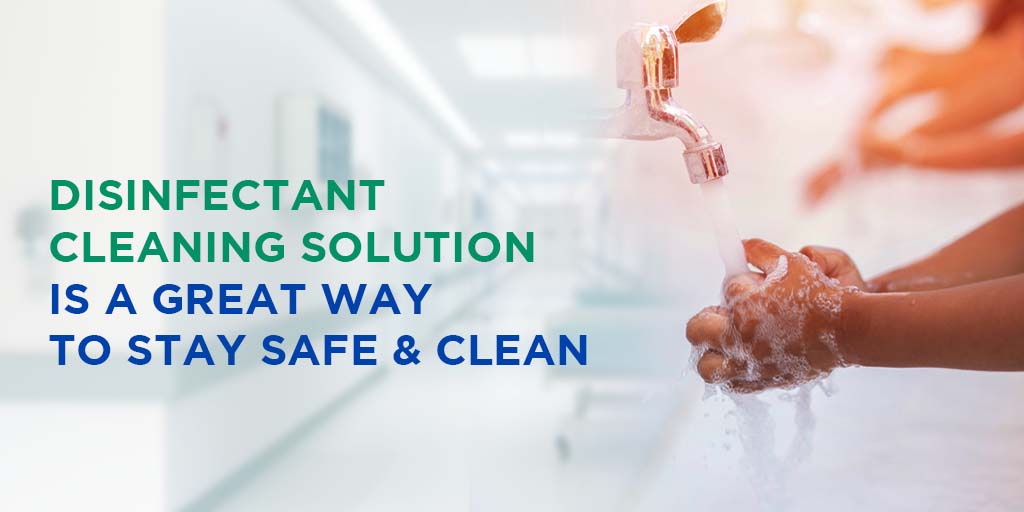
Disinfectant Cleaning Solution Is A Great Way to Stay Safe & Clean
The hospital environment is exposed to different kinds of bacteria, viruses and other pathogens on a daily basis. Good hygiene practices need to be employed in healthcare to prevent infection transmission in the hospital. It is a complex process to maintain the hygiene levels in the hospitals.
Contaminated hospital surfaces play a crucial role in the transmission of harmful pathogens, including antibiotic-resistant bacteria. The infection risk is higher when there are older patients and several medical devices are used. Surface cleaning in the healthcare sector is the go-to approach for infection prevention. In addition, maintaining hand and medical device hygiene is important.
The effectiveness of chemical disinfectants can depend on both the antimicrobial activity of the disinfectant and appropriate application, including cleaning efficiency, sufficient contact time and concentration of the disinfectant.
Cleaning Disinfectants
Mode of action
- When a disinfectant is applied or sprayed onto a contact surface, it works by destroying the structure of bacteria, viruses, or fungi present there. Every disinfectant contains an active ingredient that kills microorganisms and prevents the spread of infections or diseases. In this way, disinfectants keep surfaces in healthcare environments clean and germ-free. The disinfection activity varies with the type of chemical used.
Factors to consider when selecting a disinfectant
- With so many options available, it can be tough to select a disinfectant that works best in your healthcare environment. These 4 considerations can guide you to the right choice:
Target pathogens
- Before you select a disinfectant, find out whether it is effective against the pathogens that are the top concern in your facility. A disinfectant should fulfill specific criteria and testing requirements against target organisms and their efficacy action must be reviewed by the EPA.
Kill time
- Disinfectants are formulated to destroy specific pathogens within a certain time. The usual duration of disinfection action is between 30 seconds to 5 minutes. Depending on the kill time, the contact time with the surface will also vary. It is important to figure out the time a disinfectant takes to destroy pathogens before you go ahead with it. Make sure it works rapidly enough and is suited to the target contact surfaces.
Safety
- Since some disinfectants can cause corrosion or be toxic to the environment and users, ensure that the disinfectant you pick is safe. Verify its toxicity and flammability properties along with its safe usage guidelines, including applicability on the desired contact surface.
Usability
- The use of some disinfectants may be complex, requiring multiple steps for instance. One of the things affecting the efficacy of disinfectants is water hardness. The disinfectant you select must be easy-to-use and effective against a wide-range of pathogens.
Types of Disinfectants
- Different disinfectants are used for cleaning and sanitization in hospital networks. Let’s take a look at these and understand how their mode of action varies:
Aldehydes
- These chemicals can kill bacteria, viruses, fungi and spores, even at 2% dilution. Commonly used aldehydes are formaldehyde and glutaraldehyde. However, disinfection with aldehydes is associated with resistance among pathogens and harmful health effects in humans. That is why, many countries have banned the use of aldehydes for disinfection.
Alcohols
- All alcohol disinfectants are highly-effective antiviral and antiseptic agents when combined with water. They work by destroying the cell proteins of the pathogens. Ethyl alcohol and isopropyl alcohol are commonly used hand disinfectants. Some of the disadvantages of applying alcohol disinfectants are: they are flammable and evaporate quickly.
Chlorine compounds
- Chlorine compounds such as chlorine or sodium hypochlorite are effective sporicides, meaning they can kill spore-producing bacteria. These disinfectants act rapidly and are economically viable. But on the downside, they can be corrosive and pose a risk to cause discoloration or irritation.
Hydrogen peroxide
- It is an oxidising agent that denatures proteins and DNA in microbial cells. A 5% aqueous solution of hydrogen peroxide is enough to destroy bacteria and fungi. It can also kill viruses and bacterial spores at higher dilutions. Caution must be exercised while using concentrated hydrogen peroxide because it is unstable.
Iodophors
- Iodine gives iodophors their fungicidal, tuberculocidal, virucidal and sporicidal properties. These are commonly utilized for disinfecting medical equipment, but they can be used as antiseptics and surface disinfectants. The drawback is they tend to have an unpleasant odour, which is why they are rarely used in maintenance of hospital facilities.
Phenols
- This group of disinfectants have high efficacy against various pathogens, including viruses, fungi and bacteria causing tuberculosis (Mycobacterium tuberculosis). They work by denaturing proteins and enzymes of cells. The disadvantage of phenols is corrosion of the surfaces they come in contact with.
Quaternary ammonium compounds (QACs)
- QACs are the most preferable disinfectants in hospitals and healthcare organizations due to their low cost and rapid action. They exhibit dual action of disinfection and cleaning, making them economically viable. Quaternary ammonium compounds (QACs) can be applied in environmental sanitation of critical surfaces. These include floors and furniture and for disinfecting medical equipment that comes in contact with intact skin, for instance blood pressure cuffs. QACs are good cleaning agents that control the spread of pathogens in a hospital environment.
- Disinfectants are crucial for combating hospital-acquired infections (HAIs) and preventing the spread of pathogens. Narrowing down to a single disinfectant can be time-consuming, but it is important to choose the right chemical for your facility. Disinfectant cleaning solution by Bioguard can reduce this confusion for you.
To find out more, contact us today.


